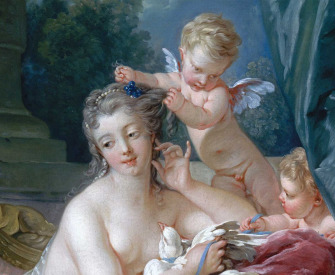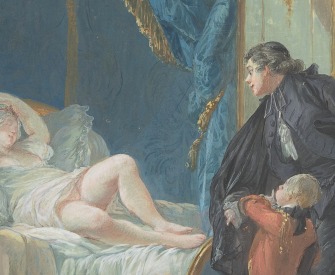I do not mean to call an elephant a vulgar animal, but if you think about him carefully, you will find that his nonvulgarity consists in such gentleness as is possible to elephantine nature—not in his insensitive hide, nor in his clumsy foot, but in the way he will lift his foot if a child lies in his way; and in his sensitive trunk, and still more sensitive mind, and capability of pique on points of honor.
—John Ruskin, 1860Our Orgiastic Future
What do bonobos have in common with teenaged boys? As it turns out, quite a bit.
By Jack Hitt
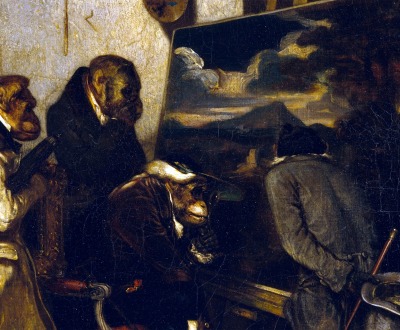
The Experts, by Alexandre-Gabriel Decamps, 1837. Metropolitan Museum of Art, H.O. Havemeyer Collection.
Audio brought to you by Curio, a Lapham’s Quarterly partner
Precisely when the ancient primates who preceded us Homo sapiens actually turned the corner to become human is one of those running battles in anthropology. Theorists scrutinize the long arc of gradual evolution to find a slight nick in the curve and there, it’s argued, our glorious ascent begins: when we began to walk upright, when we grunted out the first phonemes of speech, when we fabricated the earliest tools. Simply invoke the phrase “savannas of Africa” and inside our minds blooms a tiny movie, the tale of humanity’s bloody contest with and eventual triumph over nature somewhere around the time we left the security of dense jungles for the more progressive world flourishing at the forest’s edge.
This little drama, our secular genesis myth, divides early humanity into male hunter-gatherers and fireside female domestics. The men boldly marched out each morning with their spears and clubs to bring down a mammoth, while the women tended the fire and kept up the stores of food and clothing. Some twenty thousand years ago, life was basically the painting Neanderthal by Frank Frazetta. It’s so easy to flatter ourselves with this cartoon—hunting aurochs and taking down mammoths sounds strong and macho, but alternate theories have long suggested that a great deal of early protein probably came from more manageable prey, like vermin or deer. Spearing rabbits wouldn’t inspire Frazetta, nor, apparently, the Paleolithic artists at Lascaux, either. Which is why we’ve been spinning some version of this PR story ever since the Aurignacian-Perigordian people of southern France first scratched the smooth walls of a cave with a piece of bone.
A recent theory from Robert Sussman and Donna Hart holds that perhaps a great deal of our finest human traits may well have been refined by our ability to “evade predators.” According to scientific estimates, Sussman and Hart argue, some “6 percent to 10 percent of earlyhumans were preyed upon according to evidence that includes teeth marks on bones, talon marks on skulls, and holes in a fossil cranium into which sabertooth cat fangs fit,” and so we were under intense evolutionary pressure to develop a different kind of skill: running away. “Many of our modern human traits, including those of cooperation and socialization,” may have come from escaping predators, not hunting them. The glorious history of Homo sapiens may have less in common with the feral troglodytes found in The Clan of the Cave Bear than with Brave Sir Robin from Monty Python and the Holy Grail.
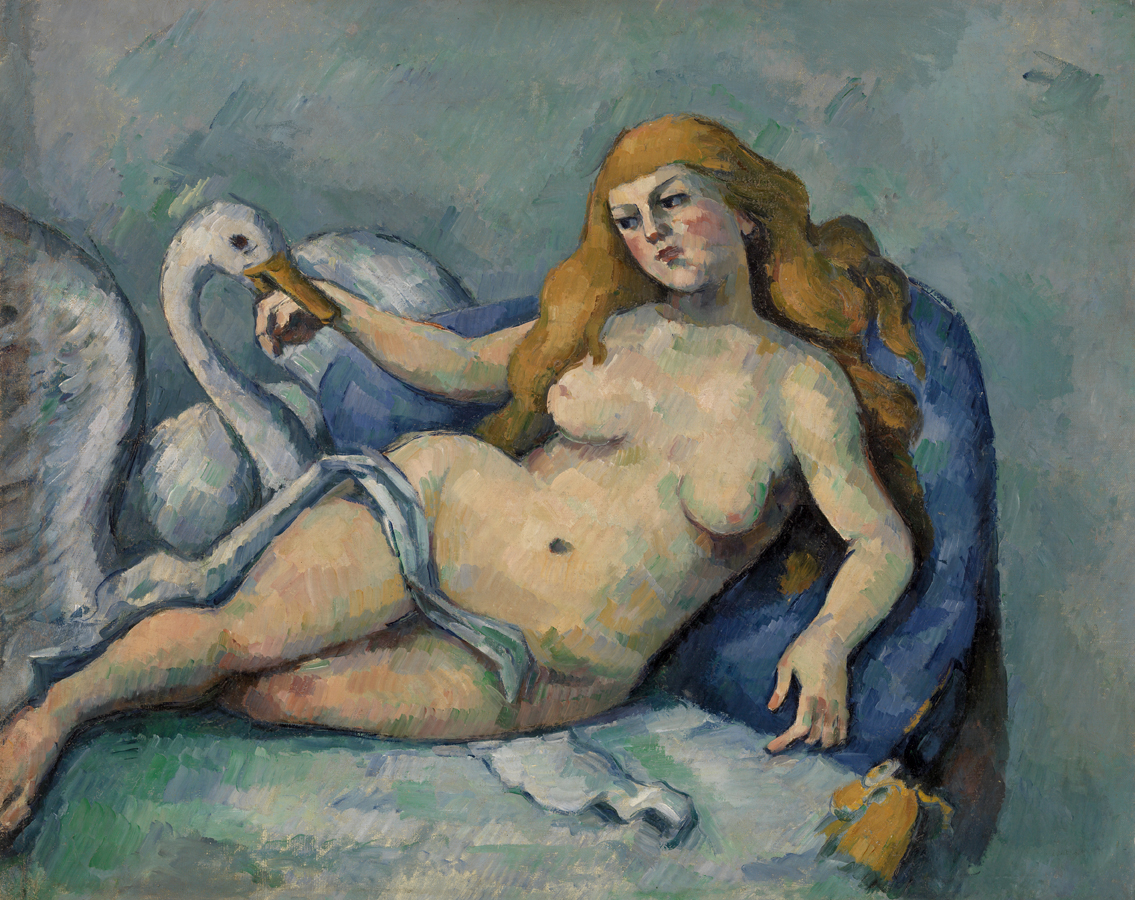
Leda and the Swan, by Paul Cézanne, c. 1880. Barnes Foundation, Philadelphia, PA.
The sequel to the savannas-of-Africa story is, as any grade-schooler knows, the “fertile crescent of Mesopotamia,” where humanity lays down the foundation of modern civilization. Throughout these little narratives, we enjoy looking back smugly at capitalized Nature and in particular the other primates—the chimpanzees, the gorillas, the orangutans—to marvel at the superiority of our evolutionary state and the hideous detritus we left behind on our way upward. Among the many signposts in our smooth, progressive arc away from all the fur, tails, and knuckle dragging is the ennobling shift to marriage and monogamy. We possess a higher sense of spiritual grace in our couplings, we are told, not merely because we have escaped the primal rut that defines the life and death of other mammals, but also because this lofty claim to love prevents society from collapsing into what the Puritans would have called a seething pit of sin and debauchery. But what if even that noble tale is, like the heroic epic of the mammoth hunter, a kind of Pleistocene PR spin, obscuring a sex life that, truth be told, is far more frisky, kinky, promiscuous, and hilarious than our cover story suggests.
In the heart of Africa, in a swamp forest near Lake Tumba in the Congo, a frolicking species of ape called the bonobo has long upset the Frazetta picture of our past. These apes, who, along with chimpanzees, share up to 98 percent of our DNA, confounded the first primatologists who observed them. Over time, they have created a colony far different from that of their intensely competitive, often violent, chimpanzee cousins. Bonobo society is based on cooperation and empathy; the culture is a matriarchy where competition is redirected into a communitarian sexual appetite. Bonobos also shocked these earliest scientists because they possessed a cheerful sense of general promiscuity, weaving wanton sex into their society, and they boasted a sexual repertoire once thought to be the exclusive property of Homo sapiens—deep kissing, foreplay, oral sex, homosexuality, and polyamory.
Which is why bonobos have gained a certain notoriety in the animal kingdom and are so often bracketed by a kind of ridicule whenever some story about them appears in the paper. “Hippie apes,” one headline will read; another is bemused by “swinger” primates—the suggestion always that what you are about to read is obviously some peripheral fluke in the otherwise bloody contest for resources and mates. And yet, some of the recent work in evolutionary biology suggests that bonobos reveal not some comically marginalized human trait but, possibly, the very mark on the long arc that leads to our humanity.
No description, academic or otherwise, can quite do justice to the comedy that is bonobo sex. On a hilarity scale of one to ten, most animal sex trends quickly toward ten. Bonobo sex goes to eleven. Throughout the day, males and females, adolescents and elders alike greet one another sexually for apparently almost any reason—and do so with everything from a quick feel, to porn-style choreographies, to elaborately athletic couplings. This feature—the variety of their easygoing sex life—is what led Duke primatologist Vanessa Woods to cheekily title her book about them Bonobo Handshake. Bonobos have deployed their elaborate sexual toolkit to ease all kinds of social transitions—ranging from saying good morning to giving the blessing before dinner to expressing a hearty welcome to a new member of the group. Females will casually present themselves to males. The male will walk right up to a female without any hesitation. All bonobos frequently have homosexual sex—the males being quite fond of hanging upside down, face to face, from a tree and engaging in what the gay community calls frottage (some primatologists call it “penis fencing”; to most teenagers it’s better known as dry humping.)
A brief visit through YouTube’s bonobo-tagged videos provides a sense of what Planet of the Apes might have looked like had it been directed by Pier Paolo Pasolini. And even though there’s been some pushback on the subject—some theorize that bonobos have more sex in captivity than in the wild—certain realities prevail: bonobos have a lot more sex and a lot more different kinds of sex than all their nonhuman cousins. And they have it outside the hormonal and biological command of estrus, the periodic season of heat that signals to most mammals that it is time to rut. This sense of freedom is what really puts them in a category quite different from the other primates and, like us, from so much of nature. And it’s not just the sex. Observers in the jungles have seen them cry and, on occasion, console a fellow bonobo in distress. In between the sexual escapades captured on YouTube, one will notice that the adults often break out of the shoulder-rolling simian swagger and walk as upright and briskly as a Manhattanite heading to the subway. Even their temperament seems closer to ours. During World War II, when the Allies bombed Munich, the city’s zookeepers are said to have reported that the chimpanzees survived the trauma of the nearby destruction. The bonobos all died of heart attacks.
That bonobos share so many of our nonviolent tendencies and yet have flourished in a Nature that we so glibly insist is defined by blood and mayhem—is why they seem so late to the primate-studies scene. Most of us grew up learning the names of Jane Goodall, who popularized chimpanzee studies, and Dian Fossey, who studied gorilla groups, and Biruté Galdikas, who worked with orangutans. All of them got their start in the 1960s and early 1970s when primate studies gained a kind of celebrity and popular following. While bonobos had been identified as a separate species from chimpanzees back in 1933, the bonobo story remained untold throughout the primate studies renaissance. Goodall became famous, in part, because she chronicled the horrific violence that characterized the life of the chimpanzee—engaging in murder and infanticide as part of the alpha male’s rise to dominate the troop and insure that he had a harem of fertile females to carry forward his DNA.
As Emory primatologist Frans de Waal has explained, Goodall’s work fed the narrative that as humans, “we were inborn killer apes.” When the bonobo story finally broke, though, it was decades later, and it was treated almost contemptuously, in particular because it challenged the easy assumptions that went with the prevalent sense that human nature was, like all of Nature, as Alfred, Lord Tennyson put it, “red in tooth and claw.” And science did what most of us do when confronted by evidence that contradicts the clichés by which we live. “It was totally ignored,” de Waal has explained. “When something doesn’t fit your thinking, the best way to deal with it is to shove it out the window and ignore it, and that’s what the scientific community did for about twenty years.”
The paper that arguably broke the news of the bonobos’ unlikely habits was coauthored in 1978 by Sue Savage-Rumbaugh. Reading Savage-Rumbaugh’s study, even today, one cannot help but sense the author’s shock despite the staid prose of an academic research paper. Writing in the Journal of Human Evolution, she published “Socio-sexual Behavior in Pan paniscus and Pan troglodytes: A Comparative Study,” a straight-up comparison of bonobos and chimpanzees. Observing bonobos in captivity, Savage-Rumbaugh probably expected to find a violent social regime similar to the one made famous by Goodall.
But as her first sentence reports, she had found “important and unexpected behavioral differences between these two closely related species.” In just about any paragraph, one comes upon a sentence where the unwritten sentiment lurking just outside the restrained and jargon-clotted syntax is “holy shit!” Perusing this paper is like watching George Will attempt a Chris Rock routine. “The external genitalia of the female Pan paniscus is rotated anteriorly, copulation takes place throughout the cycle in Pan paniscus, and homosexual copulation is a common occurrence,” she writes. Bonobos kiss while having sex, and they commonly have intercourse face to face, aka “ventro-ventral positioning.” They gaze directly into each others’ eyes, preferring, in fact, to make eye contact as often as possible. Even when they take up the classic Darwinian position—the male mounting the female from behind, aka “ventro-dorsal,” they will twist their heads to look at each other.
And bonobos do all this…a lot. Among the chimpanzees, sex occurred exclusively during estrus, that is, when female hormones signaled to the male that it was time. The male chimp sometimes fingers a female, sniffs his finger to determine if the timing is right, and if the hormonal signal is positive, then rutting commences. Otherwise the male is not at all interested. Bonobos, on the other hand, have moved way past those hormones. They would “copulate during all phases of the female’s menstrual cycle”—a human tendency as well, and one rendered crisply in the literature as “continuous receptivity.”
In the zoo where chimpanzees were caged next to bonobos, Savage-Rumbaugh observed, the male bonobo would come on to the female chimpanzees all the time. And the female chimps “responded to his soliciting gestures during all phases of their cycles by pressing their genitals close to the wire.” Since there was frequent homosexual as well as heterosexual “bouts,” a great deal of the chatter that took place among the bonobos involved deciding on a position: “Copulatory positioning among Pan paniscus is marked by considerable variability,” and a variety of signals and postures served “to communicate desired copulatory positions of each participant.”
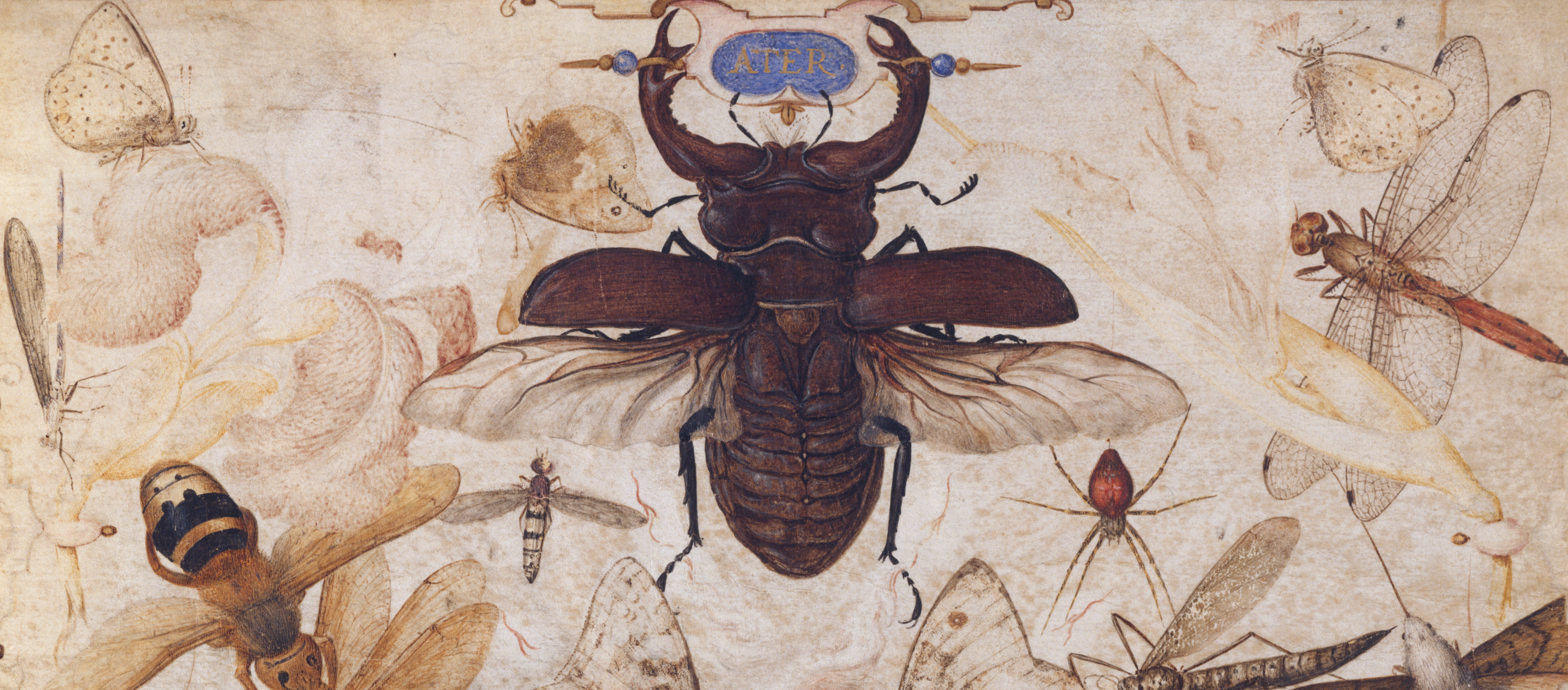
Insects and the Head of a Wind God, by Joris Hoefnagel, c. 1595. The Metropolitan Museum of Art, Gift of Mrs. Darwin Morse, 1963.
The sheer variety of bonobo sex puts the Kamasutra to shame and Savage-Rumbaugh is at her wit’s end trying to taxonomically describe the numerous positions of standing, sitting, prone, upright. Coming up with distinctions can be fatiguing when, for instance, one of the favored bonobo positions can only be described this way: the “male would at times thrust briefly during a ventro-dorsal prone bout then, while maintaining intromission, begin to walk, pushing against the female with his pelvis and moving her across the ground as she lay on her back, sometimes turning her in a complete circle before pausing to resume thrusting.” What to call that one?
The novelty and innovation never seems to end among bonobos, even after the group had been together for what in bonobo time is long past the seven-year itch: “Observations nine months later indicated that there was still no tendency toward ‘normalization’ of position or time of copulation.” Savage-Rumbaugh also chronicles the various sounds that the bonobos make while having sex. Chimps make one sound. The bonobos have a variety of cries (naturally), including one known as the “long modulated squeal.” With as much sobriety as Savage-Rumbaugh can muster, she writes, “It changes pitch and phonetic aspect at least once, sometimes twice, and is rather poorly represented as ‘we ee e.’ ”
To this day, no bonobo research grant is complete without some insane story about life among the bonobos. Vanessa Woods cheerfully described the media uproar she once caused when she confessed to the Canberra Times that she had touched the penis of a male bonobo to get him to participate in an experiment involving eating bananas. “He thrust his penis toward me,” she explained in a talk at the ScienceOnline2010 conference, “and, like, his penis is disgusting—it’s this long.” She gestured and then carried on, “So long and thin it droops toward the end like a piece of licorice. He’s refusing to do the test until I, like, touch it, and the reason why I know this is what he wants—is because men have done this to me before, maybe without the vocalizations.” The audience roared.
“And finally I’m like, all right, fine. And I touch it, like that. Instantaneous calm, and he sits down and starts eating the banana like nothing happened.” The punch line of the story is her shock that this newspaper reporter concluded that “I am masturbating bonobos to get them to do my test.”
In any human boy’s development, there comes a moment when he jokes with his friends about how weird it would be if instead of shaking hands, we just walked up to one another and handily rubbed each other’s crotches. Everybody laughs—that’s crazy. But that’s essentially what the bonobos do. Human society is replete with displays of near intimacy and suggestive touching. We have developed customs of opposite-sex and same-sex hugging and kissing, handshaking, and back patting. And all of them serve as tokens of affection, perhaps with some subtle intimation that the encounter might develop into something else. Bonobos essentially went there and then kept going. On the long arc of sexual development as primate culture, maybe we’re the missing link on the way to bonobos.
These primates so easily undermine our African genesis story, not merely by revealing that cooperation was key to our evolutionary progress but also by showing that somehow pleasure played a crucial part all along. It’s another reason why the media seem to get squeamish whenever bonobos make it into a headline. The popular press cannot be expected to seriously ask the obvious questions posed by the existence of our genetic cousins. I mean, what does it suggest that homosexuality is enjoyed with as much lustiness as heterosexuality? And what to make of the sheer casualness and breathtaking fun of their sex? A bonobo who finds a new fruit tree will report back, at which point an orgy breaks out, and then after everyone shares in the bounty, another orgy occurs as some kind of digestif. (A chimpanzee, on the other hand, might gorge itself on the fruit, guard the tree, and share only with reluctance.)
As much as our pop culture perpetuates the simple story of
Charles Darwin—natural selection equals survival of the fittest—the reality is that there are numerous pressures in the Darwinian system, and the bonobos’ existence outs us all for oversimplifying the entire business of Nature and our nature. One new study that tries to look at some of these other pressures was coauthored by Brian Hare, a Duke primatologist who happens to be married to bonobologist Vanessa Woods. His argument is that there also exists in bloody nature, besides survival of the fittest, a “selection against aggression.” He writes that “differences in morphology and behavior between bonobos and chimpanzees are analogous to differences between domesticates and their wild ancestors.” In other words, there are some animals out there whose evolutionary arcs are defined by a pressure toward “self-domestication.”
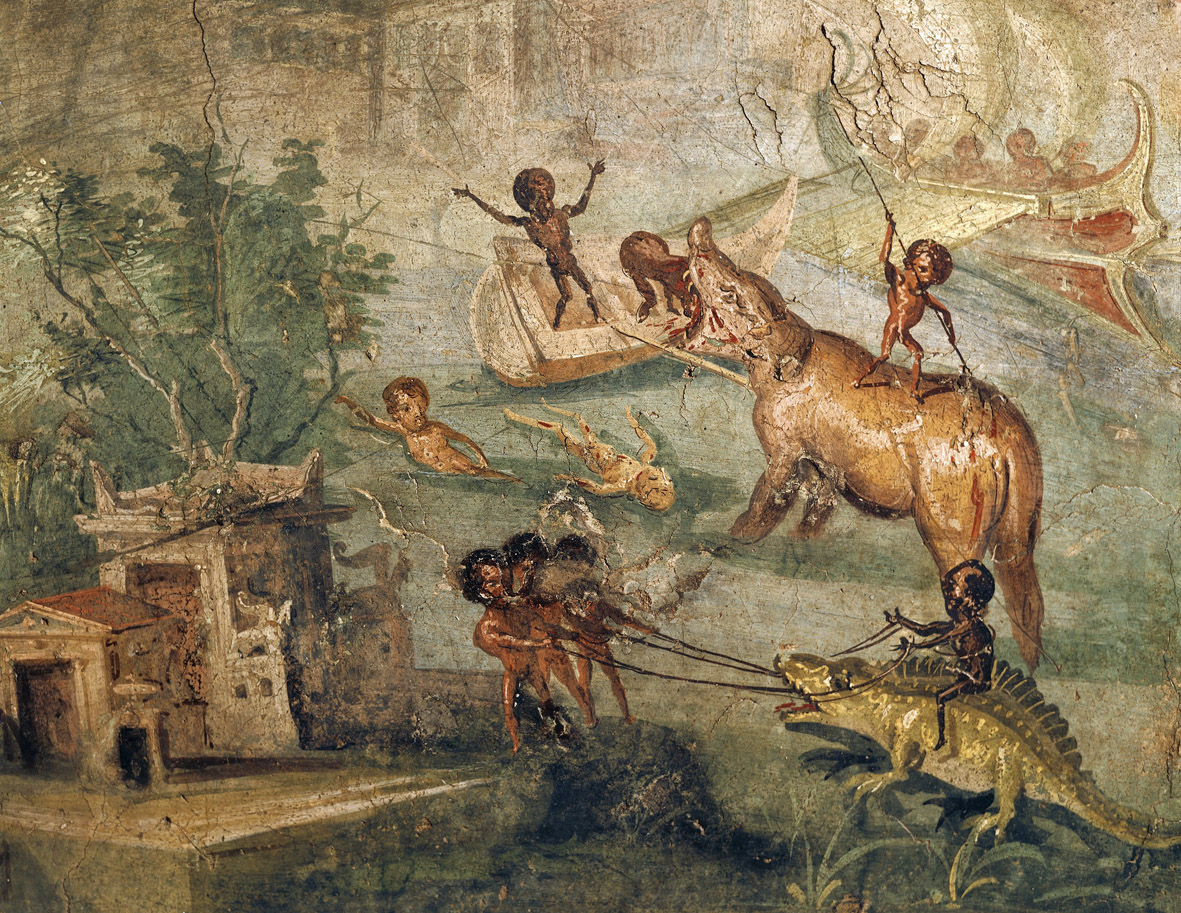
Pygmies hunting a hippopotamus and crocodile along the Nile River, fresco, Pompeii, c. 70. © De Agostini Picture Library, A. Dagli Orti, The Bridgeman Art Library.
What Hare has documented, though, is that certain other traits appear to accompany the shift toward domestication. For instance, domesticated animals become smarter, so to speak, improving their “problem-solving abilities.” They retain more of the juvenile traits into adulthood, such as head shape. They are more prone to play and grooming. Domestication is also accompanied by a series of physical changes, too. For foxes that have been selected against aggression in experiments, their stiff ears go floppy, and the tails become curly or shortened. There are certain depigmentations that occur, changes in teeth (reduction in fang size), even changes in brain size.
One of the apparent physical changes in this “selection against aggression” is an inclination toward sex unattached to procreation, a wide-ranging sense of sexual being that often embraces homosexual and heterosexual urges, masturbation, and frottage. The bonobo handshake, it turns out, is a fundamental part of domestication. In dogs, Hare notes, one of the earliest clues for a tendency toward self-domestication is a degree of sexual indulgence: a “more subtle indication that dogs are less aggressive than wolves is that dogs tend to tolerate the inspection of their anogenital region by a stranger, while wolves can become aggressive even toward group members that attempt anogenital inspections.” Given that one of the markers of being tamed is a procreative-free sense of sexuality, then even a dog’s helpless habit of frottaging a visiting dowager’s great and fleshy calf may be understood as a kind of sexual tropism, straining toward that rich and distant horizon we may now properly call bonobotopia.
The singularity of lovemaking is not the miracle of birth that can result from it—because even bees (and educated fleas) enjoy that sacrament. It’s the freewheeling cupidity enjoyed by Nature’s select few domesticates that distinguishes us. Calling it pleasure might be too anthropocentric, but whatever term you wish to summon, there, in the rainforest of the Congo, bonobos reveal that hedonists, gay or straight, constitute a vanguard of Homo sapiens who have progressed the furthest from the dull demands of procreation, representing not a deviation from the norm but an ennobling liberation from it.
